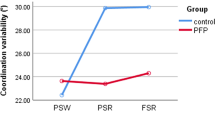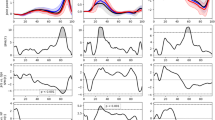Abstract
Purpose
There is a scarcity of studies evaluating the variability of couplings between proximal segments (trunk, pelvis, and thigh) in individuals with patellofemoral pain (PFP) while emerging evidence has suggested that aberrant motions of trunk and pelvis can have a contributory role in the etiology of PFP. The purpose of this study was, therefore, to evaluate the trunk, pelvis, and thigh intersegmental coordination variability in PFP compared with healthy individuals.
Methods
Thirty-four participants (17 with PFP and 17 healthy controls) walked (at preferred speed) and ran (at preferred and fixed speed) on a treadmill each trial for 30 seconds. Three-dimensional kinematics were recorded using a motion capture system. Continuous Relative Phase was used to calculate the coordination variability of couplings between trunk, pelvis, and thigh.
Results
The PFP group was significantly less variable at trunk-thigh and pelvis-thigh in frontal plane during stance at preferred speed running and trunk-pelvis in sagittal plane during swing irrespective of trial. The variability differences of the following couplings among study groups tended to be significant with the PFP group showing lesser values: trunk-thigh and pelvis-thigh in frontal plane during stance at fixed speed running, trunk-pelvis in frontal plane during swing at preferred speed running and trunk-thigh in sagittal plane during swing.
Conclusion
Lower variability in coordination of trunk, pelvis, and thigh in individuals with PFP indicates the system’s reduced ability to transit between movement patterns and to respond to different perturbations which could result in the progression of the patellofemoral joint injury.


Similar content being viewed by others
Change history
03 March 2021
A Correction to this paper has been published: https://doi.org/10.1007/s40846-021-00605-3
References
Powers, C. M., Witvrouw, E., Davis, I. S., & Crossley, K. M. (2017). Evidence-based framework for a pathomechanical model of patellofemoral pain: 2017 patellofemoral pain consensus statement from the 4th International Patellofemoral Pain Research Retreat, Manchester, UK: part 3. British Journal of Sports Medicine, 51(24), 1713–1723.
Powers, C. M. (2010). The influence of abnormal hip mechanics on knee injury: A biomechanical perspective. Journal of Orthopaedic & Sports Physical Therapy, 40(2), 42–51.
Willson, J. D., & Davis, I. S. (2008). Lower extremity mechanics of females with and without patellofemoral pain across activities with progressively greater task demands. Clinical Biomechanics, 23(2), 203–211.
Willy, R. W., Manal, K. T., Witvrouw, E. E., & Davis, I. S. (2012). Are mechanics different between male and female runners with patellofemoral pain? Medicine and Science in Sports and Exercise, 44(11), 2165.
Bazett-Jones, D. M., Cobb, S. C., Huddleston, W. E., O’connor, K. M., Armstrong, B. S., & Earl-Boehm, J. E. (2013). Effect of patellofemoral pain on strength and mechanics after an exhaustive run. Medicine & Science in Sports & Exercise, 45(7), 1331–1339.
Esculier, J.-F., Roy, J.-S., & Bouyer, L. J. (2015). Lower limb control and strength in runners with and without patellofemoral pain syndrome. Gait & Posture, 41(3), 813–819.
Noehren, B., Hamill, J., & Davis, I. (2013). Prospective evidence for a hip etiology in patellofemoral pain. Medicine and Science in Sports and Exercise, 45(6), 1120–1124.
Hamill, J., Palmer, C., & Van Emmerik, R. E. (2012). Coordinative variability and overuse injury. BMC Sports Science, Medicine and Rehabilitation, 4(1), 45.
Bernstein, N. A. (1967). The co-ordination and regulation of movements. (A Collection of Papers Translated from Russian and German.)[With Plates]. Oxford: Pergamon Press.
Turvey, M. T. (1990). Coordination. American Psychologist, 45(8), 938.
Kelso, J. (1984). Phase transitions and critical behavior in human bimanual coordination. American Journal of Physiology-Regulatory, Integrative and Comparative Physiology, 246(6), R1000–R1004.
Kelso, J. S. (1995). Dynamic patterns: The self-organization of brain and behavior. Cambridge: MIT press.
Hamill, J., van Emmerik, R. E., Heiderscheit, B. C., & Li, L. (1999). A dynamical systems approach to lower extremity running injuries. Clinical Biomechanics, 14(5), 297–308.
Cunningham, T. J., Mullineaux, D. R., Noehren, B., Shapiro, R., & Uhl, T. L. (2014). Coupling angle variability in healthy and patellofemoral pain runners. Clinical Biomechanics, 29(3), 317–322.
Heiderscheit, B. C., Hamill, J., & van Emmerik, R. E. (2002). Variability of stride characteristics and joint coordination among individuals with unilateral patellofemoral pain. Journal of Applied Biomechanics, 18(2), 110–121.
Jewell, C., Weir, G., Hamill, J., & Boyer, K. A. (2018). The influence of patellofemoral pain on coordination variability over a prolonged treadmill run. ISBS Proceedings Archive, 36(1), 634.
Haghighat, F., Rezaie, M., Ebrahimi, S., Shokouhyan, S.M., Motealleh, A., & Parnianpour, M. (2020). Coordination variability during walking and running in individuals with and without patellofemoral pain Part 1: Lower limb intersegmental coordination variability. Journal of Medical and Biological Engineering, (in press).
Willson, J. D., Dougherty, C. P., Ireland, M. L., & Davis, I. M. (2005). Core stability and its relationship to lower extremity function and injury. JAAOS-Journal of the American Academy of Orthopaedic Surgeons, 13(5), 316–325.
Alvim, F., Cerqueira, L., Netto, A. D. A., Leite, G., & Muniz, A. (2015). Comparison of five kinematic-based identification methods of foot contact events during treadmill walking and running at different speeds. Journal of Applied Biomechanics, 31(5), 383–388.
Rotstein, A., Inbar, O., Berginsky, T., & Meckel, Y. (2005). Preferred transition speed between walking and running: Effects of training status. Medicine and Science in Sports and Exercise, 37(11), 1864.
Lamb, P. F., & Stöckl, M. (2014). On the use of continuous relative phase: Review of current approaches and outline for a new standard. Clinical Biomechanics, 29(5), 484–493.
Schache, A. G., Bennell, K. L., Blanch, P. D., & Wrigley, T. V. (1999). The coordinated movement of the lumbo–pelvic–hip complex during running: A literature review. Gait & Posture, 10(1), 30–47.
Miller, R. H., Chang, R., Baird, J. L., Van Emmerik, R. E., & Hamill, J. (2010). Variability in kinematic coupling assessed by vector coding and continuous relative phase. Journal of Biomechanics, 43(13), 2554–2560.
Stergiou, N., Harbourne, R. T., & Cavanaugh, J. T. (2006). Optimal movement variability: A new theoretical perspective for neurologic physical therapy. Journal of Neurologic Physical Therapy, 30(3), 120–129.
Mehdizadeh, S., & Glazier, P. S. (2018). Order error in the calculation of continuous relative phase. Journal of Biomechanics, 73, 243–248.
Acknowledgements
The current article was extracted from the Ph.D. thesis written by Farzaneh Haghighat. We thank the scientific and financial support from Shiraz University of Medical Sciences, the Deputy for Research Affairs, and the School of Rehabilitation Sciences.
Funding
This work was financially supported by Shiraz University of Medical Sciences (Grant Number: 97–01-04–17431).
Author information
Authors and Affiliations
Corresponding author
Ethics declarations
Conflict of interest
The authors declare no conflict of interest.
Ethical Approval
Ethical approval was granted by the local Ethics Committee of Shiraz University of Medical Sciences (IR.SUMS.REHAB.REC.1397.006).
Additional information
The original Online version of this article was revised “In the original publication, there were errors in some sentences, Figure legends, and Tables that are corrected”.
In the original publication, there were errors in some sentences, Figure legends, and Tables that are corrected.
Rights and permissions
About this article
Cite this article
Haghighat, F., Rezaie, M., Ebrahimi, S. et al. Coordination Variability During Walking and Running in Individuals With and Without Patellofemoral Pain Part 2: Proximal Segments Coordination Variability. J. Med. Biol. Eng. 41, 305–313 (2021). https://doi.org/10.1007/s40846-021-00598-z
Received:
Accepted:
Published:
Issue Date:
DOI: https://doi.org/10.1007/s40846-021-00598-z




